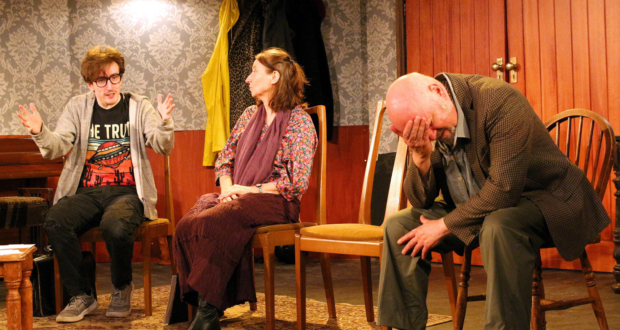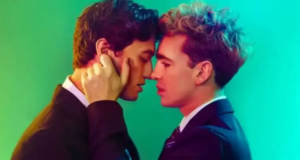Sci-fi, and thrillers and musicals, oh my! Summary
Rating
Ok
Improbable Fiction experiments with merging multiple genres, as writers collaborate. In the first act, a writers’ circle meeting occurs, then in the second a play emerges that is the combination of their work. The production begins with Arnold, (Sean Mcmullan), the chair and writer of instruction manuals, anxiously preparing his home for the meeting. Notably, he’s only really involved as his house has the space to host. This sets up his character for the rest of the play. His ordinary, rather plain demeanour helps to dampen the other more eccentric characters.
Slowly, the others are introduced in a way reminiscent of an Agatha Christie, entering one by one, windswept from the outside snowstorm. It’s a strong entrance from each, immediately showing who their characters are; whether it’s the ambitious journalist, the bitter retired teacher, the timid and insecure mother, and so on. They are somewhat stock characters, yet the way they have all met to discuss their common passion – writing – allows them to work well together.
Although the play takes a while to gather any pace, author Alan Ayckbourn uses this opportunity to set up the second act. Everybody is introduced along with their methods of writing, which complement their character; whether that’s being constantly struck by inspiration and able to produce novel after novel, or if it’s methodically curating a whole universe in their mind but being too afraid to write it out, in fear of ruining what’s been created. This allows for some interesting discussions on questions such as what it means to be a writer; they’re in a writers’ circle, but does it count if someone has never actually written anything yet?
Unfortunately, the disjointed narrative of the second act means that an opportunity to really display how the writers can work well together is missed. As they each adopt a new character, the play that emerges is more a collection of three separate works: a Victorian ghost story, a 1940s thriller and an absurd sci-fi mystery turned children’s novel.
They’re brought together whilst Arnold, who remains himself, acting as the ‘straight man’, creates a bridge between the audience and the show. However, this makes it slightly harder to become immersed within the new play. His role also feels rather redundant: he does not offer any answers to the questions the audience may be asking, only pointing out the obvious, and at moments brought the energy down. This is particularly so at the end of the first act, where the next portion of the story is teased before the interval. Ending with a scream and a clap of lightning would be perfect, yet Arnold’s fumbling and questioning ruins the suspense created.
If Arnold had simply joined in with the multi-roling and become a character too Ayckbourn could have focused on making a more consistent piece, so his character was not needed to ask, ‘what’s going on?’ The genres of each writer do range greatly, and it would be hard to fit all their preferred styles into one; but isn’t that kind of the point?
It’s clear which character has written which bit, whether it be the romance element, rhyming couplets, and even a musical interlude; albeit slightly on the nose at points. This, however, doesn’t really matter. The point of the play isn’t to be good, it’s to experiment with being able to incorporate multiple writing styles into one cohesive work.
Despite this, it is an entertaining storyline and an interesting insight into the minds of the writers. Being able to experience multiple shows in one adds to the element of surprise and it kept me engaged, wondering where it was all going.
Written by: Alan Ayckbourn
Directed by: Phillip Ley
Set Design by: Phillip Ley
Costume Design by: Jean Carr, Emma Efkeman, Isabel Putt
Lighting Design by: Andrew Maxted
Sound Design by: Laurence Tuerk
Music by: Colin Guthrie
Choreography by: Kornelia Adelajda
Improbable Fiction plays at Tower Theatre until 12 November. Further information and bookings can be found here.
 Everything Theatre Reviews, interviews and news for theatre lovers, London and beyond
Everything Theatre Reviews, interviews and news for theatre lovers, London and beyond



